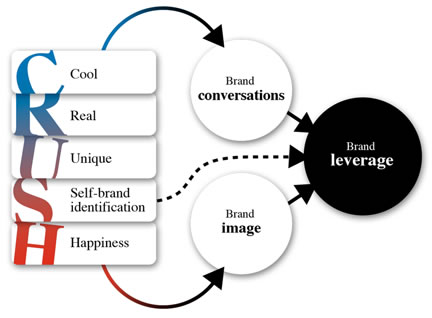Joeri Van den Bergh, co-founder of InSites Consulting and co-author of “How Cool Brands Stay Hot” has spent the last 5 years researching Generation Y with some of Europe’s top brands here he talks about the research carried out and what the new consumer means for the future of marketing.
The book has been a number of the years in the making, but, at what point during the initial research did you feel thatwork needed to be done in understanding how to engage with Generation Y?
Actually it all started with the chapter on self-identification; 5 years ago we had to make a traditional segmentation of the youth population in Belgium for MTV Belgium. We came up with the traditional segments you always find based on the Schwartz values, but, when we looked at the results and the descriptions of the different segments we felt that it didn’t resemble the youngsters we saw around us and their differences. I think the first conclusion back then was that this was not a good way to look at youth. It’s the traditional way of looking at lifestyles but it wasn’t working for youth, so the year afterwards, in the next episode of that research project we proposed to MTV to go a step further and carry out ethnographic research. I think it was the first paper I wrote for ESOMAR’s qualitative conference 3 years ago. We followed teenagers aged 11 to 17 years during 6 weeks, online day-to-day; gave them assignments, asked them to take a lot of pictures of their bedrooms; of the places they spend time together with their friends, make videos of what they were doing and also blog everyday during the 6 weeks.
From these qualitative insights we drew an initial scheme that was later validated with all the ‘tribes’. What we saw was that the differences weren’t explained by the Schwartz values; they actually were explained by totally different dimensions; those dimensions are explained in the book such as differing on the way you look or the skills you have. It was a new way of looking at youth and that was the first step in the book and later became the chapter on self –identification.
In the research we wanted to make the link between this identity forming phase in life, between 11 and 17, and what brands should do. I thought we had a great scheme back then but it was hard to make a link on how brands should deal with this. So then the next step was go further on brand personality. We had the personality of youth from the 6 week ethnographic research, with all their differences but the link with brands was hard to make. In the Netherlands the next year we took lists of brands and asked the youth what brand personality they like, what their favourite brands were. And integrating this with the new scheme of different lifestyles we could then make the relationship between them clear. Branding on one hand and youth lifestyles on the other hand; that was the starting point of the book.
The CRUSH components are the five aspects key for brand leverage to Generation Y, how did you come about building this model?
As I mentioned before, we started with the “S”. We saw that we had to find a new way of, not classifying youth, but understanding differences between youngsters. The next step was all the work we did around coolness. The next year we did the authenticity study which we presented as a paper for ESOMAR Qualitative conference in Marrakech. Authenticity was done for Levis, but coolness studies we did for 15 different industries. Year after year we saw that the same branding and brand personality aspects came back all the time. It was always about having a unique style, simplicity, real and not imitation. These aspects came back in all research, always the same components. We played a bit with the attributes we saw and came up with the acronym which was of course useful when you want to have something that people remember. Then we needed to validate it, and we did this study before we started writing the book. We asked both Gen Y’ers and older generations in 7 European countries to share their favourite brand with us and to write a story about their brands in different categories; mobile phones, snack- foods and fashion. We then text-mined these stories to see what was popping up in every story and whether it was different talking about their favourite brands or their least favourite brands. We then quantified it and created items to measure different components. So that’s how we came up with the model and then we made the relation to the initial model that Steven (Van Bellegham’s, author of The Conversation Manager) was already using in his book, which is a conversation based model linked with image, identification and brand leverage. CRUSH was the next dimension, explaining the brand steps inside the conversations of Generation Y.
Some of that initial research used young teens as respondents, at an age that is a notoriously difficult time for teenagers as they struggle themselves with self-identification. Where there challenges in getting teens to open up during that period of their lives?
Yeah sure, especially for the youngest ones. The age of 11 and 12 is really a difficult age because your body starts to change and you have all these insecurities in life and peer pressure. But of course in our sample we followed 40 teens in 2 cities, there were differences between more introverted and more extroverted youngsters. But actually because it was an online method it gave a more anonymous ‘stranger on the train’ effect. We also became friends with them on social media, so we didn’t just have what they were reporting to us, we also saw what they were sharing with their friends online. In the initial stage of the research they were more closed, but after a while they forgot somebody was watching them and the blog just became part of their daily routine and daily life, just like posting messages on social media. In the end we didn’t see any differences between who they were or how they represented themselves on social media with their friends and what they were telling us on the blog. The most awkward thing for them was probably that their parents were very interested in what they were telling us. We had a lot of teens saying afterwards that their parents wanted to read everything that they had written. We had a closing session where we met everyone face to face with their parents and some of their parents were still very eager to find out what the conclusion was for their child specifically. Of course we didn’t give them that information.
There’s an advantage of these online methodologies with this age group. If there’s an adult sitting in front of them asking questions it would be a lot harder to get these kinds of details about their lifestyle. We just told them we were interested in their life, in youth life and after the 6 weeks we want to know how life is like for a 12 year old, so put everything on your blog that you think we need to know about you and your life and take pictures of whatever you think is important to you. So it wasn’t really a threatening way to interview them, and they could share whatever they wanted to, it wasn’t really ‘top-bottom’ method, that would be the wrong way to approach this generation.
You mention that clients can sometimes have an aversion to the term ‘cool’, as it’s often associated with youth. And in the book you generally refer to Generation Y as ‘youth culture’. But of course at the top end of the generational scale, Gen Y’ers are in their late twenties, so can the same aspects you focus on in the book apply to all of Gen Y or are they more relevant to the current youth market?
Well it’s broader even, considering afterwards I could have easily written the book with the same back bone, and the same model of what makes brands interesting or hot as an insight into the ‘new consumer.’ A lot of things we see in Generation Y are affecting society, which means the older generation tend to follow the direction in which Gen Y moves. The classic example being mobile and social media. Which is something that has, in many ways, been introduced by Generation Y. Ecological behaviour is another one that is high on the agenda of this new generation and copied by their parents because their relationship is so close. And now what you often see is that parents want to be cool too. The parents of Generation Y are actually turning their heads towards their children and looking at what brands they are buying, what products do they want, what technologies should they adapt to? So that’s the reason why this model and this backbone of the book, it’s not only relevant for the teens, it’s relevant for new consumerism as well.
As marketing adapts to new consumers, market research obviously needs to adapt as well. How geared towards the new consumer do you feel the industry is at the moment?
There have been some companies that are adapting to this new way of talking to people, so doing research without asking questions for instance and analysing what people are already sharing in forums and social media, the netnography approach and text mining. I think what was still fascinating in the 3 last years since the ESOMAR Qualitative Conference is that there seems to be two separate worlds within one sector. You have the traditional qualitative researchers and the new qual researchers which combine and fuse new methods in qual research and have a more direct and long term interaction and conversation with consumers. Rather than just two or three hours around a table or ‘behind the mirror’. And that fascinates me because I thought at this point everyone would be on the same line, and would be doing less traditional focus groups because if you want to have a real representative view of how consumers are thinking you need to talk to a different profile of people that would never be in the room and participate in those kind of sessions but are sharing their opinion online. You certainly have the agencies that are doing this type of research but there are a large segment of companies that are not doing research on that level.
Do you feel that the rise in online qualitative research will signal the end of traditional focus groups?
There is always going to be room for that type of research, sensory research for example. Where people need to touch and feel will always be done face to face, in real life situations. There are still many clients that prefer to see the respondent, although if you do a combination of ethnography and online and you follow people for 6 months and let them take pictures everyday, make videos of themselves, I thinkyou have a better view of their life and a broader view of who they are compared to meeting them for 2 hours in an artificial space. You will always have customers that like to be behind the mirror and see the 3D version of their consumers because they want to connect with them. On the other hand I think that combining not only the online-ethnographic method and online discussion group but also with face-to-face moments like a real-life ‘safari’ where you bring the client in contact with their customers in a face-to-face situation in their homes can be more valuable in time than putting 8 people around a table and discussing things. Will it entirely disappear? Not for the next couple of years. The movement in qualitative is actually a little slower than I expected, and I think the reason why is that the qualitative part of the industry, what you may call the human part of research, the face-to-face feelings and emotions can be a hurdle to using new methods.
Do you think the current privacy issues surrounding social media research may be a making the shift a little tentative?
I don’t think it should be a barrier because the industry is evolving towards a more community research approach where you recruit respondents on social media and request to follow them for a certain period. If they agree to become friends on Facebook we just analyse what they are doing. But then it’s completely opt-in, the same as traditional qualitative research but in a longer term.
So, what do you see in store for Generation Z?
From an early age they are already using iPhones and iPads, that kind of new technology. They’re raised with digital TV, they can stop live action to see something that was on the previous day and going back into the live action, skipping advertisements. They’re used to new media at a very early age. So it will be more intuitive way of using tools. But the question is what will the effect of this be on personality and what they will desire from brands and from society and politics. I think it’s too early to detect it at this point. The only thing we know is that they are connecting to others faster. If you look, for instance, at the age at which they’re spending time together, staying over at friends etc, they are starting this at 2 or 3. So they will be a much more social generation for sure and used to many new tools, multi-tasking all the time. What this means to brands, we are unsure. We need more research.
 Joeri Van den Bergh, co-founder of InSites Consulting and co-author of “How Cool Brands Stay Hot.”
Joeri Van den Bergh, co-founder of InSites Consulting and co-author of “How Cool Brands Stay Hot.”




2 comments
myTectra provides online training as well as classroom training. The trainers here are real time experienced professionals in that particular domain. The training is more on Practical sessions.
myTectra not only Provide students on most popular courses like Machine learning, python, AWS and much more but also Trains corporate training for professionals. We have around 600+ courses and experienced trainers for all the courses.
[…] expert Joeri van den Bergh, author of How Cool Brands Stay Hot and co-founder of InSites Consulting […]